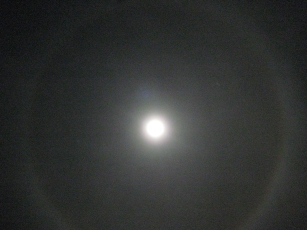Copyright © 2011 Joseph Mack
20 Dec 2011, released under GPL-v3
Abstract
A photo of a 22° halo around the moon 2115 EST 15 Feb 2011, Durham NC, USA. The inside of the halo was tinged with red (just noticable in the photo) and the outside tinge with blue (not easy to see in the photo).
Table of Contents
About 10 yrs ago, in the early fall (the season when the skies are clear and cloudless), I was at my son's start-of-school-year picnic. Looking up in the clear blue early afternoon sky, I was dumbstruck to see something I didn't know existed; circular arcs in the sky with intense rainbow colors in places. I saw all of the arcs in the the diagram Frequent Halos (http://www.atoptics.co.uk/halo/common.htm). Having been an an amateur astronomer and professional scientist all my life, I thought there wasn't a whole lot I didn't know about, even if I didn't understand it, especially natural phenomena that could be observed unaided. It had to be caused by ice crystals in the upper atmosphere, but beyond that I had no idea.
There were 500 other adults at the picnic. No-one was looking up. I showed the arcs to all around. They politely replied "that's nice" and returned to their conversations. These are the parents of the next generation, who in a few decades will themselves be adults running the earth. Clearly I didn't have a lot in common with the parents of my son's peers. What was I doing in this school?
On returning home and searching with google, I found explanations for the arcs. I found that the intensely sundogs are quite common. Halos can be seen about every 3 days or so (depending where you are). Travellers in the artic and antarctic see arcs in dazzling color all the time - sometimes they won't go away.
The main problem seeing them is that we spend so much time indoors. I bought the book Rainbows, Halos and Glories by Robert Greenler, which has many colored photos and explained the causes the various arcs. Greeler has a photo of his house during the day, with the expected blue sky. He has another taken at night (a longer exposure) under a full moon. Guess what color the sky is under a full moon [1]?
For the next few years, I looked up at the sky when ever I was out. I found that I could see sundogs whenever the geometry was right (cloud at 22° from the sun and at the same altitude as the sun, as long as the cloud was semi-transparent i.e. you could see at least a hint of blue behind the cloud). Summer with its thick cumulus clouds wasn't great for arcs or sundogs, but winter with thin stratus or cirrus clouds were good. I saw iridescence at the edge of clouds 22° away from the sun. I saw a 360° white arc once, when the sun was high in the sky, while at one of my son's soccer games, but the soccer parents weren't any more interested in it, than were the adults at the school picnic. I often found sundogs looking out the window at work and started showing them to co-workers. One of the people (a radio astronomer) didn't know about them either, but after showing him what they were, came in the next day telling me that he'd seen a moon dog that very night. I'd never thought of looking for a moon dog. The amount of time I spend outdoors at night looking up is small. How was I ever going to see a moon-dog?
Figure 1. Moon ring with faint color fringes 2115EST 15 Feb 2011, Durham, NC, USA - photo courtesy Austin Mack
My neighbour, an academic at Duke University was interested in all sorts of things and I'd shown him sun dogs. One night there was a loud knocking at the door, it was the neighbour. Outside was a complete 22° circle arc the moon. The neighbour was excitedly telling me that he'd never seen such a thing. It even had faint color fringes (red inside, blue outside). I had my son take a few photos using his point and shoot. The shot was hand held and my son had limited shutter control, so the photos weren't as colored as the ring.
[1] it's sky blue. The two photos are identical except the trees in the night photo are a bit blurry.
